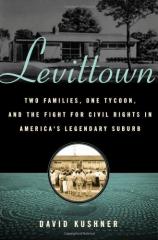Levittown: Two Families, One Tycoon, and The Fight for Civil Rights in America’s Legendary Suburb
Review
Levittown: Two Families, One Tycoon, and The Fight for Civil Rights in America’s Legendary Suburb
To some, the name “Levittown” conjures up images of
crushing conformity spread out in row upon row of soulless Cape Cod
“boxes.” To others, it represents the ingenious
entrepreneurial spirit of Levitt & Sons, the dynamic
homebuilder embodied in the person of William Levitt, who enabled
the wave of World War II veterans to purchase comfortable, if
modest (two bedrooms, a living room, kitchen and bathroom)
mass-produced dwellings for less than $8,000. Without question, the
story of Levittown reflects fundamental elements of America's
post-war ethos.
Whether it was Brown v. Board of Education’s
challenge to the segregated classrooms of Topeka, Kansas, or the
bus boycott in Montgomery, Alabama, the 1950s likewise brought
forth the first determined statements of the modern civil rights
movement in America. In his stirring new book, David Kushner weaves
these strands with Levitt's story to illuminate a lesser known but
no less dramatic event in those tumultuous years --- the struggle
to integrate the whites-only community of Levittown,
Pennsylvania.
In 1957, Daisy and William Myers, an unassuming African-American
couple living in Bucks County, Pennsylvania, dreamed the simple
dream of millions of Americans of their generation: a new home in a
good neighborhood in which to raise their growing family. That
spring, their wish coincided with the political agenda of a group
of Levittown residents led by Communist-leaning, Jewish political
activists Bea and Lew Wechsler, who sought to shatter the racial
barriers of the community. When the Wechslers’ next door
neighbor’s house went on the market, they approached the
Myerses about moving in. Their arrival, in August 1957, sparked an
outpouring of protest, often violent, severely testing whether
blacks and whites could live peacefully in the country's
fast-growing suburban communities.
The protests of the ironically named Levittown Betterment
Committee (some 1,200 members strong at one point and supported by
the Ku Klux Klan) featured everything from a cross burning, to
relentless noise and vandalism, to purchasing the home behind the
Myerses (the protestors called it the “Confederate
House”) as a base for harassing operations. The attacks on
the Myerses and their supporters came to a head in September 1957,
the same month President Eisenhower called on the National Guard to
oversee the integration of the public schools of Little Rock,
Arkansas. Effectively exposing the deplorable passivity of the
local police, Kushner also chronicles the involvement of law
enforcement authorities of the Commonwealth of Pennsylvania,
tentative at first, but later applied with full force in a dramatic
trial in December 1957.
Kushner sketches contrasting portraits of the politically
motivated Wechslers and the quiet but no less determined Myerses,
whose courage made the integration of Levittown possible.
There’s something especially moving in the account of the
heroism of the Myers family, including that of their children,
forced to confront both the extremes of harsh treatment and the
loneliness that came from having only a handful of friends in a
hostile environment.
While the picture of Bill Levitt that emerges from
Kushner’s book is decidedly unsympathetic, it’s
nevertheless a multifaceted and nuanced one. Levitt was a
hard-driving, at times unscrupulous, businessman whose morals were
dubious (for years he carried on an affair in a secluded estate in
Levittown, Pennsylvania) but who gave generously to Jewish causes.
There’s no doubt his Levittown communities made homes
available to hundreds of thousands who, in some cases, had been
living in chicken coops before those developments sprouted from
what once had been farmland. But the dark side of Levitt’s
brilliant success was his determination to maintain the racially
segregated communities he believed (with the support, at least for
a time, of misguided federal housing policies) were the only way to
preserve home values. Levitt left behind a complex legacy,”
Kushner concludes, “a man who both provided the American
Dream to a generation of veterans and denied it to an entire
race.”
Kushner employs a low-key, journalistic style and never becomes
polemical or judgmental. Still, it’s clear where his
sympathies, as would those of any right thinking person, lie in the
contest between the mindless mob and the strong-willed protagonists
of this modern morality play. “By standing up for their
rights, and for each other, the Myerses and Wechslers --- two
families from different worlds --- showed the power that neighbors
can conjure up when they choose to come together.” This is a
story well worth telling and one well told in an affecting account
of humanity at its worst and ultimately triumphant best.
Reviewed by Harvey Freedenberg (mwn52@aol.com) on December 30, 2010
Levittown: Two Families, One Tycoon, and The Fight for Civil Rights in America’s Legendary Suburb
- Publication Date: February 3, 2009
- Genres: History, Nonfiction
- Hardcover: 256 pages
- Publisher: Walker & Company
- ISBN-10: 0802716199
- ISBN-13: 9780802716194





